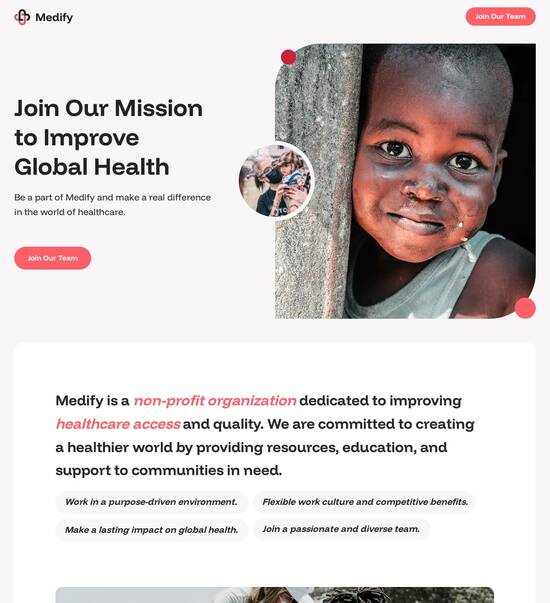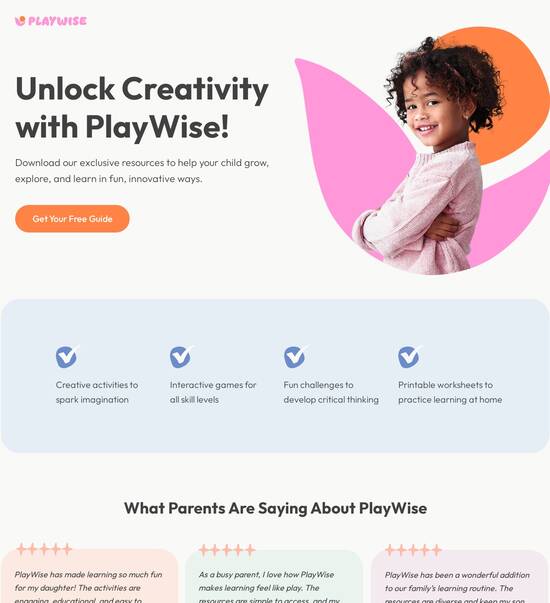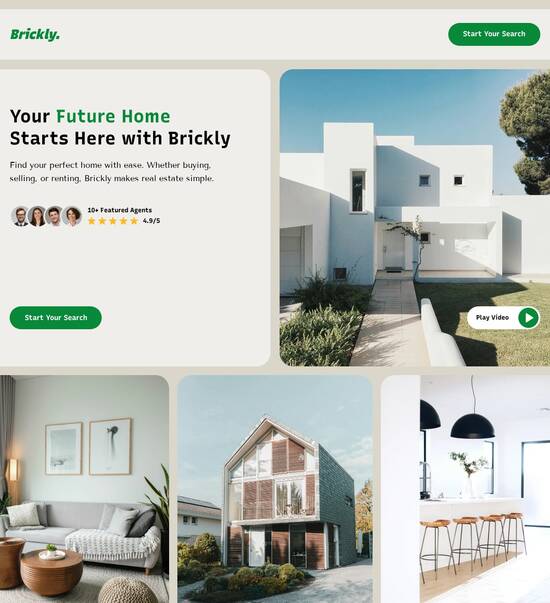
Changelog page template compatible with Wix
Explore Similar TemplatesAbout template
Build and integrate high-converting changelog page templates with Wix effortlessly!
Recommended templates

Easy to build without coding
With the intuitive drag-and-drop builder, anyone on your team can create high-converting pages without any knowledge of code or design. Make enhancements to your landing page with custom widgets using Javascript, HTML/CSS, or third-party scripts.

Multiple layouts for any industry and goal
Select from 500+ landing page layouts built to boost conversions across industry-specific scenarios. Customize them by adjusting fonts, adding images, and generating on-brand content with the AI assistant. Quickly scale with Instablocks® and Global Blocks that you can save, reuse, and update globally.

Loads fast and looks polished on any device
Every template is responsive, which means they present professionally on any device and load blazingly fast with our Thor Render Engine. You can also power them up with Google AMP technology to deliver an unparalleled mobile experience and drive higher conversions.

Robust analytics & experimentation
Get real-time updates and reporting across all your devices, showing the number of visitors, conversions, cost-per-visitor, and cost-per-lead. Launch AI-powered experiments, run A/B tests, and use heatmaps to analyze user behavior, then optimize your landing page to maximize conversions.







Easy to build without coding
With the intuitive drag-and-drop builder, anyone on your team can create high-converting pages without any knowledge of code or design. Make enhancements to your landing page with custom widgets using Javascript, HTML/CSS, or third-party scripts.
Multiple layouts for any industry and goal
Select from 500+ landing page layouts built to boost conversions across industry-specific scenarios. Customize them by adjusting fonts, adding images, and generating on-brand content with the AI assistant. Quickly scale with Instablocks® and Global Blocks that you can save, reuse, and update globally.
Loads fast and looks polished on any device
Every template is responsive, which means they present professionally on any device and load blazingly fast with our Thor Render Engine.
Robust analytics & experimentation
Get real-time updates and reporting across all your devices, showing the number of visitors, conversions, cost-per-visitor, and cost-per-lead. Launch AI-powered experiments, run A/B tests, and use heatmaps to analyze user behavior, then optimize your landing page to maximize conversions.
All the features you need to build lead-generating landing pages
Explore more featuresLearn how to build top-performing landing pages for any goal
FAQs
Leading the way in building high-performing landing pages





A step-by-step guide to maximizing ROI with Instapage's landing page platform
In the fast-paced world of digital marketing, maximizing ROI is paramount, and Instapage's landing page and conversion rate optimization (CRO) platform offers unique tools to help marketers achieve that goal. With its user-friendly interface and robust features, Instapage allows you to effortlessly create high-converting landing pages tailored to your audience.
Understanding the importance of landing pages
Landing pages serve as the crucial intersection between your digital ads and conversions, acting as dedicated portals for visitor engagement. A well-structured landing page compels your audience to take action, whether it's signing up for a newsletter or making a purchase. Therefore, optimizing these pages is fundamental, and this guide will walk you through the steps to make the most of Instapage.
- Targeting specific audience segments: Customize landing pages based on your audience's needs.
- Utilizing high-converting templates: Leverage Instapage's library of over 100 templates to save time and increase effectiveness.
- Integrating lead generation elements: Embed forms and calls to action to capture visitor information seamlessly.
Step 1: Create your landing page using Instapage's templates
Creating an effective landing page begins with choosing the right design template. Instapage provides a plethora of conversion-focused layouts that you can modify to align with your brand and goals.
- Explore and select a template: Navigate through the diverse options to find a suitable base for your content.
- Use intuitive drag-and-drop builders: Customize elements without needing coding expertise to ensure the page feels personal and engaging.
- Incorporate strong visuals: Utilize the built-in image library to add relevant, high-quality images that resonate with your message.
Step 2: Optimize your landing page for conversions
Once your page is created, the next step is optimization. Instapage grants you advanced features including A/B testing and heatmaps, allowing you to see how visitors interact with your page.
- Conduct A/B tests: Test variations of headlines, images, and calls to action to see what resonates most with users.
- Analyze heatmap data: Understand which parts of your page draw the most attention and rework elements that receive little interaction.
- Continuously iterate: Use insights gained from analyses to refine content and layout.
Step 3: Personalize the user experience
Personalization plays a crucial role in enhancing customer engagement and conversion rates. With Instapage's dynamic text replacement and audience tracking features, you can deliver targeted experiences to various visitor segments.
- Implement dynamic text: Tailor your landing page copy based on the source of your traffic (e.g., keywords or ad campaigns).
- Utilize AdMaps: Align specific ads with their relevant landing pages to ensure visitors see a cohesive message.
- Track metrics by audience: Measure performance according to different demographics to tailor future campaigns effectively.
By following these steps, marketers within business services, tech, and other sectors can leverage Instapage's features to enhance their landing pages and improve overall campaign performance.
Ready to take your digital marketing strategy to the next level? Sign up for Instapage today and start maximizing your ROI with optimized, high-converting landing pages.
People also ask about Changelog page template compatible with Wix
Understanding the changelog page template for Wix: A comprehensive guide
The concept of a changelog page
A changelog page serves as a comprehensive record detailing all the modifications made to a website or software over time. It highlights new features, bug fixes, and other relevant updates aimed at informing users of changes that impact their experience. The purpose of such a page is multifaceted—primarily, it fosters transparency and keeps users in the loop about developments. For businesses, especially those offering digital products or services, this page is a vital communication tool that establishes trust and shows commitment to improvement.
Historically, changelogs have been utilized primarily in software development but have gained traction across various digital platforms as the landscape has evolved. As websites transitioned from static pages to dynamic environments, the importance of changelogs grew, enabling businesses to keep track of their updates while also providing valuable context to users. This evolution has contributed to a better user experience, showcasing a company's dedication to innovation and reliability.
Integrating a changelog page with Wix
Wix is celebrated for its user-friendly interface and versatility, making it an ideal platform for various types of businesses. With its intuitive drag-and-drop functionality and a rich library of customizable templates, Wix simplifies the design process for users, regardless of their technical skills. Furthermore, Wix accommodates businesses across diverse sectors, featuring templates tailored to industries such as e-commerce, education, and professional services.
A changelog page is easily integrated into a Wix website, as the platform supports the creation of dynamic pages. Users can construct a changelog by utilizing Wix’s built-in tools to add items sequentially, categorizing updates by date or type. This straightforward process involves creating a new page, applying a suitable template, and inputting changes within visually appealing sections. Users can include various elements, such as images or links to blog posts detailing each change, ensuring the information is engaging and informative.
Key features of changelog page template in Wix
When designing a changelog page on Wix, it's essential to consider visual design elements that will appeal to users. Wix offers a plethora of customizable options, allowing users to select fonts, colors, and layouts that align with their brand identity. One vital aspect of a changelog page is its mobile responsiveness; as more users access websites on mobile devices, ensuring that the changelog maintains readability and functionality is crucial for user engagement.
In addition to design, incorporating user engagement tools significantly enhances the effectiveness of changelog pages. Widgets such as comment sections, feedback forms, and social media sharing buttons can encourage visitors to interact with the content. By allowing users to provide their opinions, businesses can gain valuable insights into how updates are perceived, which can guide future changes and foster a sense of community around the brand.
Crafting the perfect changelog
Creating an effective changelog requires thoughtful content structuring. Each update should ideally include key elements such as the date of the change, a clear description of what was modified, and any relevant links to additional information. By maintaining a chronological order, users can easily track changes over time. Additionally, employing visuals like icons, images, or videos can greatly enhance clarity and make the changelog more engaging.
Optimizing the changelog for search engines is also crucial to ensure that users can find this information easily. By identifying relevant keywords and strategically integrating them throughout the content, businesses can improve their visibility. Furthermore, the changelog can support broader content strategies by linking to related blog posts or service pages that explain the context of changes, helping to improve overall site SEO.
Leveraging AI for enhanced changelog functionality
Artificial intelligence (AI) has the potential to significantly enhance the functionality of changelog pages. One way AI can contribute is through content suggestions that refine language, ensuring that change descriptions are clear and concise. Additionally, AI can help automate the process of notifying clients and team members about updates, streamlining communication and fostering a proactive approach to change management.
In terms of analytics, AI tools can track visitor engagement with the changelog, allowing businesses to assess which updates generate the most interest. This information can inform decisions concerning product development and client communication strategies, as understanding traffic patterns helps teams pinpoint what resonates most with their audience.
Utilizing the changelog page across various business types
For e-commerce websites, a changelog page is valuable for sharing updates regarding product alterations, shipping policies, and changes to business operations. Considering a case study example where an online store regularly updated its changelog, it noticed improved customer satisfaction as customers appreciated being informed about new features and product restocks. This transparency not only enhances brand loyalty but also reduces the volume of customer inquiries about changes.
Service-oriented businesses can leverage changelogs to manage appointments, reservations, or service modifications, keeping clients informed about operational shifts. In this context, frequent updates can enhance client trust and satisfaction as they realize the business is committed to providing timely information. Similar practices apply to portfolios and creative freelancers, where changelogs can showcase project progress and newly completed work, enticing potential clients with innovative updates.
Enhancing collaboration through changelogs
A changelog page is not just an external communication tool, but it also serves as an internal resource for staff members. Utilizing changelogs to update employees on new features, training sessions, and policy changes maintains a cohesive understanding of the company’s direction. Regular communication via this medium can help gather staff feedback, encouraging team members to share their ideas and thoughts about ongoing changes.
For client relations, changelogs can nurture transparency, creating a trustworthy relationship with clients by keeping them informed about updates or developments. Consistent communication through changelog updates allows businesses to strengthen client relationships and encourage a sense of community, ultimately leading to enhanced customer loyalty and satisfaction.
Troubleshooting and support
During the integration of a changelog page on Wix, users may encounter a few common issues. Some of these include formatting challenges or difficulty in adding dynamic elements. To troubleshoot, it is advisable to ensure that the correct templates are being used and to double-check that updates are input in the proper structure. Additionally, users can utilize various Wix resources such as the extensive help center or video tutorials that guide through the setup processes.
Wix support offers a host of options for assistance, including live chat and email support for resolving specific queries. Community forums serve as valuable platforms where users can ask questions or share solutions, tapping into the experiences of fellow users in the Wix ecosystem.
Future trends: evolving changelog pages
As technology advances, changelog pages are likely to see new innovations in both design and functionality. Anticipated trends include the integration of more AI-driven experiences, such as automated summarization of updates and real-time interactions through chatbots. This evolution will further enhance client engagement as users will have quick access to information about changes without the need for extensive browsing.
Moreover, the adaptability of changelog page templates will ensure businesses can swiftly accommodate new features and updates reflecting changing business needs. Continuous improvement will be key; therefore, maintaining fresh, relevant content will be essential in sustaining audience interest and trust over time.
Ready to skyrocket conversions?
Supercharge your ad campaigns with high-performing landing pages
Get started














